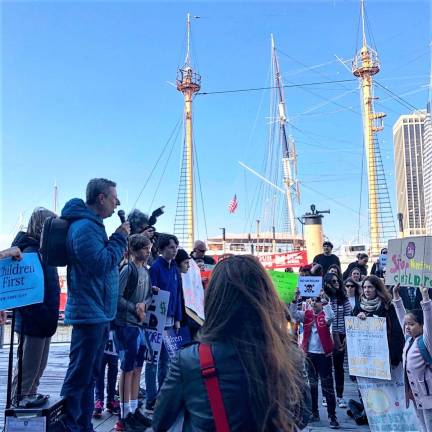'Poison parking lot' protest

A coalition of parents, activists and residents rallied together Thursday at the South Street Seaport to protest Howard Hughes Corp. over its plans to break ground on the site of a former thermometer factory, running the risk of exposing the community and school children to mercury.
The site, a parking lot, takes up an entire city block on Water Street and sits at the doorsteps of both Peck Slip School and the private Blue School. The protestors, galvanized by local mothers of Children's First NYC, fear that disturbing the area will unleash toxins into the air.
Health Threat for Students“The mother lode of mercury is in here,” said Elaine Kennedy, director of the board of nearby South Bridge Towers and a chair of Seaport Planning and Preservation, at the rally. “Once we open this site up, we expose this entire community.”
At the demonstration, which took place outside the Howard Hughes Corp. building at the Seaport, children held up signs stating, “Mercury poisons kids,” “Leave the lot alone,” and “Not on our watch.”
The coalition has received backing from activists and politicians including activist and state committee member Christopher Marte, Assembly Member Yuh-Line Niou and city Comptroller Scott Stringer.
“The health and safety of our city's children and local communities is paramount to a sustainable future,” Stringer said. “Any development that is planned for 250 Water Street must have a robust remediation plan that seeks to determine the true extent of all harmful chemicals that may be present at or around the site.”
Community vs CorporationLast year, the Howard Hughes Corp. purchased the lot for $180 million from Milstein Properties, which had tried and failed to develop the site over several decades. The company has not submitted any plans for development to the city, but it has applied to be included in the state's Brownfield Cleanup Program after finding contaminates in the soil. The program is typically used to revitalize economically blighted communities, incentivizing private-sector cleanups with tax credits.
The community, however, does not want the developer to be approved until it has submitted plans for the lot and the site has been thoroughly reviewed and tested by an outside third party. The group does not have confidence in the Howard Hughes Corp. as they feel it has so far misled the community and concealed its intentions.
“Why can't we trust HHC to put children first?” asked Megan Malvern, a co-president of the PTA at Peck Slip. “Because they lied to us. They misled the community from the start.”
When Howard Hughes Corp. tested the site, results showed mercury and petroleum in the soil. But Malvern said they didn't directly test the areas where the thermometer factory buildings had been, a location plotted by one of the mothers involved in the protest. In addition, Malvern said, the company did not adequately assess the type of chemicals found in the soil.
“Why didn't they find out about elemental mercury?” Malvern asked the nearly 200 people in attendance at the rally. “It's expensive and really hard to clean up. Nearly impossible. If you don't find it, I guess you don't have to clean it up.”
The Developer RespondsCristina Carlson, the Howard Hughes Corp.'s vice president of corporate communications and public relations, said in a statement that the developer is committed to the safety and wellbeing of the Seaport neighborhood, and its remediation plans are part of that commitment. “It is critical that the extent of the site's contamination is determined, especially given its complex history, so that we can fulfill our responsibility to prepare a comprehensive and expert remediation plan,” Carlson said.
The company, Carlson said, has initiated the process of planning the investigation that must take place prior to creating a remediation plan. She said the developer wants the process to be transparent.
Additionally, residents fear that Howard Hughes Corp. are planning to build a 70-plus-story structure at the lot, which is not within the architectural context of the Seaport. In 2003, a rezoning effort set the limit at 12 stories, but the developer owns substantial air rights at nearby properties that could be transferred to 250 Water Street through a rigorous process and community board approval.
A Quick and Safe Cleanup Community Board 1 sent a resolution to the Department of Environmental Conservation (DEC), which runs the Brownfield program, stating that it did not want the Howard Hughes Corp. to be included in the program until the details of the company's plans for the lot were made public and approved.
“We're not anti-development by any means, but we certainly understand that the project should not move forward until it's ready to move forward,” said Michael Kramer, who is a steering committee member of Save Our Seaport and a public member of the community board.
Kramer said the community wants a quick and safe cleanup process and a development that is within the context of the historical neighborhood. “We don't want them to dig a big hole and for them to leave it empty for a year or two through the zoning process or while they're trying to transfer air rights,” he said.
At this time, the DEC is still reviewing the 250 comments it received from community members regarding the Brownfield application. “In response to community concerns and the number of public comments received for this application, DEC will provide the public with a summary of all comments received that responds to all comments and questions,” an agency spokesperson told Straus News.
The agency said it had expected to make the decision as early as March, but two months later it's unclear when the decision will come.